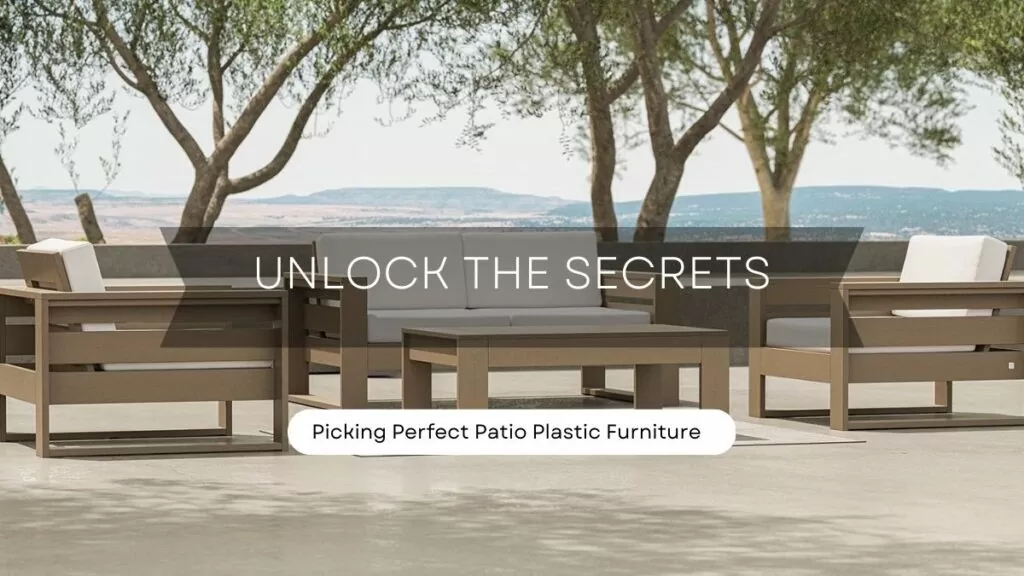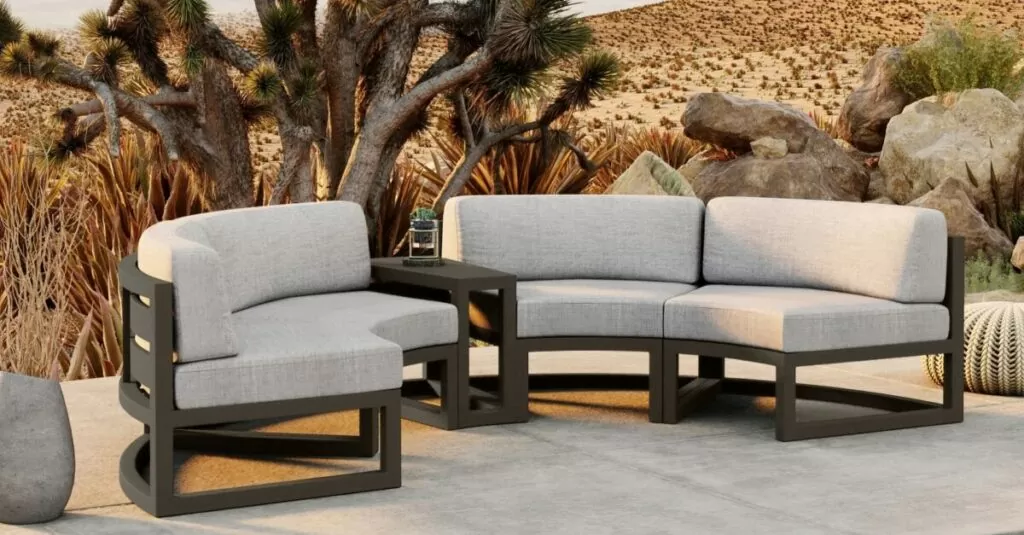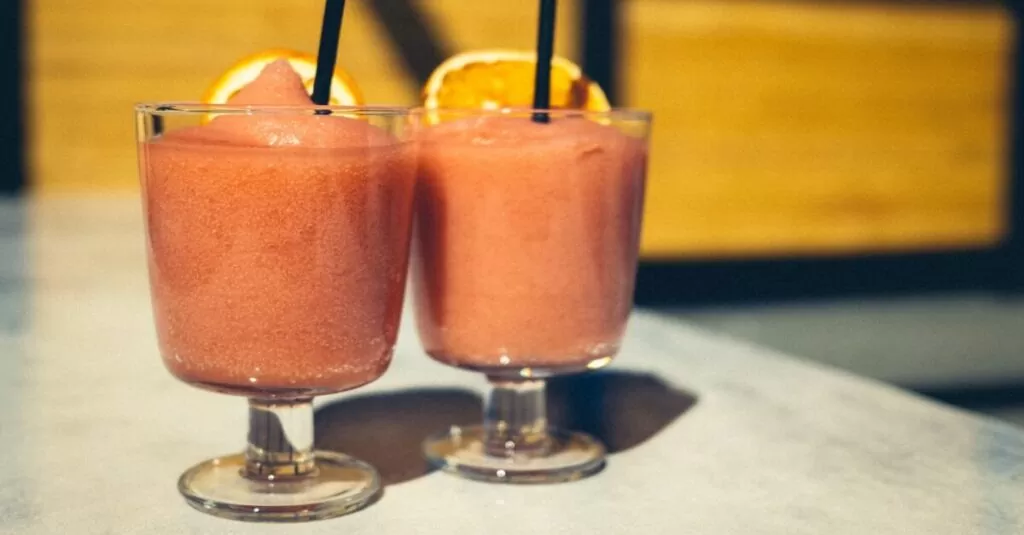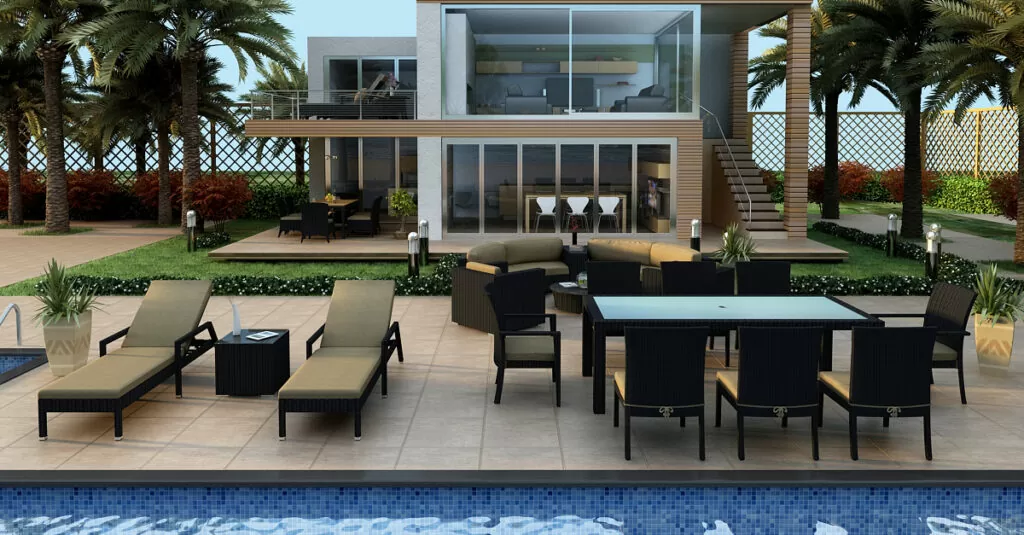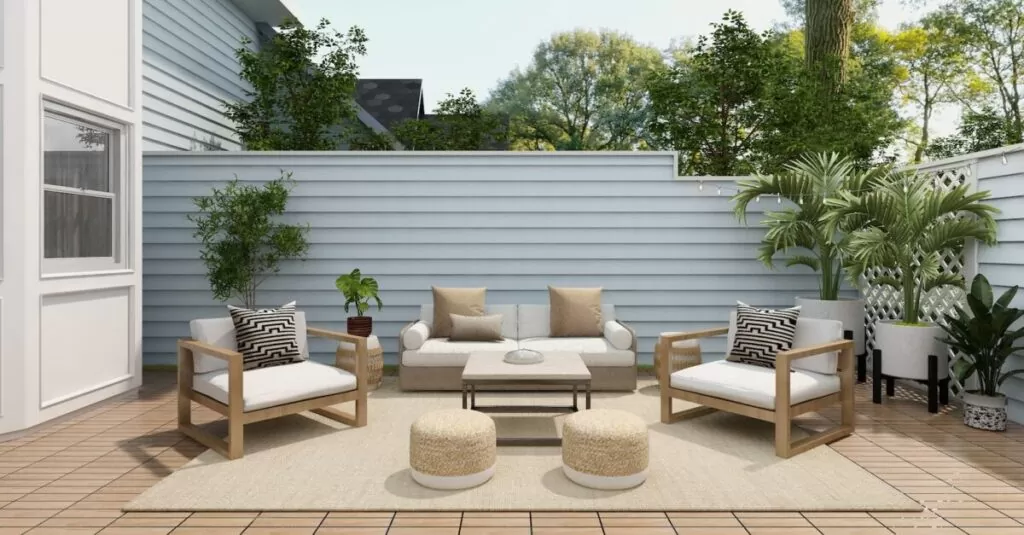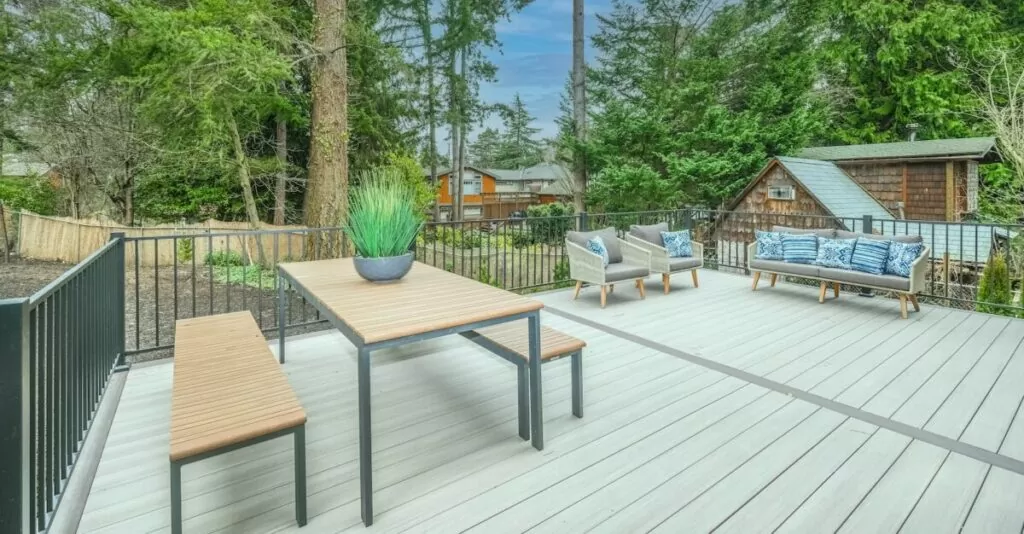Hey there patio pal, let’s talk about plastic! Plastic patio furniture, that is. Don’t worry, we won’t be ‘poly-mesmerizing’ you with overly long chit chat about boring chemistry and the physics of certain thermoplastics (I mean, unless you want that? Leave a comment below!).
Instead, we’ll take a closer look at three super popular types of plastic patio furniture: PVC, HDPE (high density polypropylene), and poly-lumber (often called composite wood). We’ll examine the pros and cons of each material to help you make an informed decision when you get shopping for some fine patio furniture of your own. PVC is your run-of-the-mill budget-friendly option, HDPE is more eco-friendly and generally much higher quality, and poly-lumber strives to offer the look and feel of real wood without all the maintenance that comes with all-natural material. Whether you prefer a pristine PVC piece or a poly-lumber lounger, plastic patio furniture is a perfect pick for practically any outdoor space. And with new manufacture methods available to us, it is often a sustainable option too! So, let’s dive into the nitty-gritty of each type: PVC, HDPE, poly-lumber, and their many pluses and predicaments.
Consider the Different Materials Available
When you’re taking a look at some new patio furniture, one of the first decisions to consider is what type of material you would like for your outdoor pieces. There are several different types of materials available when it comes to selecting patio furniture and all of them have their own unique properties. Obviously, were just talking about plastic in this post. But if you want to explore other options, check out our article on the best patio furniture materials!
First up: let’s talk strength. Synthetic materials tend to be much stronger and more durable than natural products such as wood and can offer greater long-term protection against exposure to ultraviolet rays and inclement weather patterns than many other alternatives. Cost-wise, synthetic plastic materials may be slightly more expensive in comparison to some of the other common furniture material available; however, they are very easy to maintain and often last far longer due to their superior strength and durability. These are just two considerations in a sea of options.
Truly, deciding which material best suits your needs depends on a huge number of factors including cost and maintenance requirements and durability, but also, more abstract things like style preferences and more situational things like the typical weather conditions of your home region.
Whichever option you choose, it’s important to take these into account before making the final selection. After you’ve evaluated your options it’ll be time to decide on the style of furniture that best reflects your personal preferences. But again, this one’s just about plastics. So, let’s look at various types of typical synthetic materials that are suitable for patio furniture in a little more detail.
HDPE For Patio Furniture
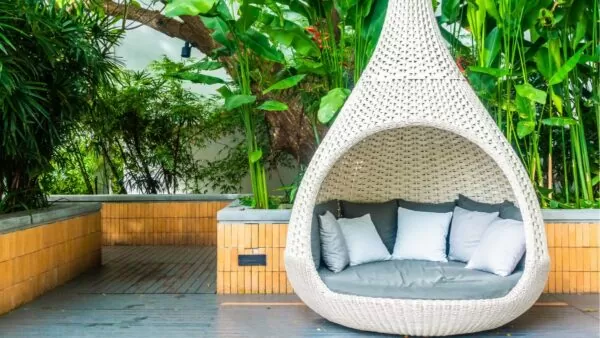
High-density polyethylene (HDPE) is a popular material used to make outdoor furniture – most commonly, this is the material that famously makes up ‘ outdoor wicker furniture ‘. It is strong, durable, weatherproof, and resists stains and scratches. Additionally, it requires little maintenance and is lightweight compared to other materials like wood or metal. Additionally, it is also more affordable than other options making it attractive in terms of cost.
However, HDPE may be less appealing because of an unnatural feel as compared to wood or metal furniture. Additionally, when exposed to direct sunlight for long periods of time, the color of the material may start to fade. Furthermore, HDPE may lack the unique appearance that comes with wooden pieces or different metals.
For shoppers looking for a low-maintenance and cost-effective solution for outdoor furniture, HDPE remains an attractive solution. However, shoppers should consider if the artificial look and potential fading are worth the tradeoff for a lower price when considering this material for patio furniture.
Moving on from exploring HDPE for patio furniture, the next section will focus on Poly Lumber — an alternative synthetic plastic material that has become increasingly popular in recent years.
Poly Lumber

Poly lumber, also known as synthetic lumber or composite wood, is an increasingly popular choice for outdoor furniture. Poly lumber outdoor furniture is a composite material that rivals the look of traditional wood, but with much greater durability and weather resistance. It typically consists of high-density recycled plastic molded into a wood-like shape, which is ideal for use in outdoor furniture applications. For starters, it won’t rot, crack, peel or corrode in any way like wood does when exposed to outdoor elements. Additionally, it can easily be drilled, cut and sanded to fit the exact size and shape desired for most patio furniture pieces.
As far as advantages go, poly lumber will not require sanding or painting like real wood would need to maintain its attractive appearance. Plus, it’s much lighter than its wooden counterpart, which makes it easy to move around your yard. Furthermore, many types of poly lumber are designed for uniform color throughout and are available in a variety of textures such as smooth or rough finish. Finally, poly lumber tends to be less expensive than other outdoor materials like metal or teak.
On the flip side of things, one potential drawback of using poly lumber for outdoor furniture is that it can be more susceptible to fading if left out in direct sunlight for extended periods of time. It can also become brittle if not maintained properly over time due to UV rays breaking down the plastic fibers. Some people also find that poly lumber doesn’t have the same warmth and feeling of real wood, so they may prefer one style over another depending on their preference.
Poly lumber can be an excellent choice for patio furniture depending on your needs and budget. Whether you’re looking for something durable that resists wear and tear from the elements or something more economical than teak or metal, poly lumber might just fit the bill perfectly.
PVC For Patio Furniture

PVC is a low cost plastic, however, because it is petroleum based it is not environmentally friendly in comparison to other types of plastics. If the price of the furniture is too good to be true it is becuase it is made of PVC. PVC does tend to be waterproof, which makes it suitable for outdoor furniture, thus providing an all-weather solution for patio furniture.
PVC is not biodegradable nor recyclable. This means that once disposed of, PVC breaks down into hazardous pollutants that can seep into the ground and water sources, contaminating them and ultimately doing damage to the environment. On the other hand, PVC is thought by some to be a durable material perfect for outdoor furniture pieces subject to harsh winds or rainfall.
While PVC is moderately strong, at least strong enough to be sold at your typical big box patio furniture store, it doesn’t hold up well to prolonged UV exposure. PVC tends to get brittle in too much sunlight over time, especially in areas that experience lots of rain-sun cycling. This is the main reason that we actually don’t sell any PVC furniture in our catalog; it simply doesn’t hold up long enough to meet our quality standard. HDPE and composite wood are much longer-lasting and can simply take more punishment from the weather.
It’s important to weigh both sides of the debate when deciding whether or not PVC is the best choice for your patio furniture needs. Despite potential environmental damage, it remains a popular option due its resilience and affordability. However, we at Patio Productions would suggest considering other eco-friendly options before purchasing this type of plastic and is not a type of plastic we promote.
Generally, what we advise is: if you are looking for a lower up-front price point and are comfortable (or, even prefer) buying new patio furniture every two or three seasons, go with PVC. If you want a patio set that will last, go with HDPE or composite wood. Even polycarbonate and resin patio furniture outlasts PVC by a substantial margin, and is well worth considering.
Now that we have discussed the merits and drawbacks of using PVC in patio furniture and established clear criteria for your decision making process, let’s move on to explore the suitability for outdoor furniture usage in our next section.
Suitability for Outdoor Furniture Usage

When deciding on which plastic to use for furniture pieces meant for outdoor use, suitability needs to be taken into consideration. While some may think that plastic is an unsuitable material for outdoor furniture and should only be used indoors, this is not the case; modern developments and research have made plastic an ideal option for both indoor and outdoor usage. Plastic furniture has come to market with added features such as UV light resistance, which prevents fading from the sun’s rays, and integration of a variety of components designed to make the furniture more durable which holds up well in the elements.
Modern iterations of plastic for furniture are made with comfort in mind– durable in construction yet yielding enough to provide comfortable seating. Patio furniture made with these modern plastics has permanent colorings that look far better than their predecessors, while also being resistant to mold and mildew growth over time thanks to its low water absorption characteristics. For areas exposed to moisture, certain polyethylene varieties are adequately prepared to face any weather conditions they will encounter.
The most suitable plastic variants available today will offer high levels of strength and compatibility with all kinds of environment quality. This makes plastic a great selection despite originally having the reputation it did; it is lightweight on top of the other advantages listed above making patio furniture easily movable when needed.
Natural materials like wood are still widely preferred for outdoor environments for their classic aesthetic quality, much different from plastic furniture’s industrial-looking affordable charm. Nevertheless, it cannot be denied that modern plastics have quickly become one of the best options out there for patio furniture users –and luckily, we now have enough options available at our disposal so that everyone can find something suitable to their personal tastes in aesthetics as well as quality.
With that said, transitioning our focus into UV light resistance and aesthetic appeal seems like a sensible next step when choosing plastic patio furniture– two essential features worth examining before making your ultimate decision.
UV Light Resistance and Aesthetic Appeal

When making the decision on which plastic to purchase for outdoor patio furniture, it’s important to weigh both its UV light resistance and aesthetic appeal. Plastic materials often offer impressive aesthetic qualities with a large range of color options, as well as durability and strength. However, many plastics may not be resistant to the damaging effects of UV rays found in sunlight. This can cause fading, chalking, cracking, or other physical changes in the plastic product overtime, ruining the overall look and potentially causing further problems such as leaks.
When choosing a plastic type for your patio furniture, take the time to verify if it is UV stable and read reviews or research customer feedback to make sure that plastic type won’t become brittle or crack just after a few months of being outside. If you’re looking for something of a higher quality material that offers longer lasting protection, consider using Polyethylene (PE). PE plastics provide superior UV lightning protection and enhanced resistance performance against harsh weather and chemicals without losing its original color over time or becoming brittle in colder months.
The key is striking a balance between the material’s resistance to environmental conditions and its aesthetic appeal – no one wants an outdoor chair that looks dull or ugly! Researching ahead of time to get more insight into different types of plastics will ensure you are equipped with all the necessary information before buying your patio furniture items.
After taking all these considerations into account, it’s now time to think about other factors to consider when shopping for patio furniture plastic. From price comparisons between brands to making sure the plastics fit in with your existing outdoor aesthetics – considering each of these components carefully will help you choose the best plastic for your patio furniture project needs.
Factors to Consider When Shopping For Plastic Patio Furniture

When shopping for patio furniture plastic, there are several factors to consider in order to ensure you make an informed decision. UV light resistance and aesthetic appeal are two important considerations; however, several other factors should be taken into consideration when choosing the best material for your patio furniture.
Durability is one factor to take into account when selecting a plastic type for outdoor furniture. Unlike metals or wood, plastics can become brittle when exposed to constant sunlight and temperature fluctuations. To ensure your outdoor furniture lasts, it’s important to choose an appropriate grade of polypropylene or polyethylene plastic that is both durable and weather resistant. Generally, high-density indoor/outdoor furniture grades are best for most applications. If you live at higher elevations or in areas where temperatures drop below freezing, choosing the correct grade may necessitate the use of special additives such as antioxidants to protect against extreme temperatures.
Budget is another crucial factor to consider when perusing various plastic types for outdoor furniture. While prices can vary greatly from supplier to supplier and by plastic type, there is always a vast price range within each type of plastic. In some cases lower density materials may be suitable for inexpensive outdoor furniture projects due to their low cost; however, durability may suffer under extended exposure to harsh conditions so something of higher grade, with UV inhibitors added and a better warranty is probably the more practical choice in most instances.
The ability to customize your furniture while preserving unique shapes and designs is yet another factor when selecting a particular type of plastic for outdoor use. Most commonly used plastics today have advanced capabilities which allow them be easily cut with traditional woodworking tools while still preserving intricate details like edges and grooves that are often difficult with other materials like metal or wood. This can be especially useful when creating custom pieces such as benches and chairs where exact measurements are essential.
Before purchasing plastic for any project, it’s important that you carefully weigh all the options available to ensure the end product meets your needs both adequately and within your budget constraints. While aesthetics and UV resistance are always two of the primary concerns when shopping for patio furniture plastic, these factors alone should not overshadow considerations such as cost, durability and customizability – all of which play integral roles in choosing the best material possible for your outdoor environment.

Todd is a co-owner of Patio Productions and has worked extensively in the furniture industry since 2002, when he started a company that designed and manufactured bathroom vanities. He now has a hand in all online business operations, including keeping tabs on industry trends and making sure Patio Productions remains an innovative leader in the outdoor furniture space. He lives just outside of Denver, Colorado with his wife, two boys, and two dogs. They live on a lake where they can make the most of the outdoor lifestyle. His favorite patio furniture sets are his Harmonia Living sectionals.

